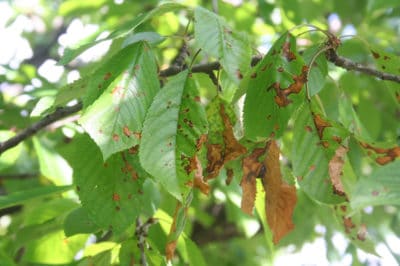How to Spot Cherry Leaf Spot
Cherry leaf spot disease, also known as shothole disease, first appears on the leaves of the tree and can be identified by these symptoms:
- Leaves turning yellow,
- Leaves falling prematurely from the tree,
- Infected leaves have round, purple, red, or brown spots which later turn black in color,
- Infected spots on leaves can fall out, leaving holes in the leaves,
- Individual spots sometimes grow together, forming irregular patches of discoloration on the leaf surface,
- Large portions of the tree can become defoliated during the growing season,
- Lesions can also affect fruit and twigs.
Cherry leaf spot is most common on Morello cherry varieties, which are a type of sour cherry. However, this pathogen also attacks sweet cherry and plum trees.
Life Cycle of Cherry Leaf Spot Fungus
A fungus, Blumeriella jaapii, is responsible for cherry leaf spot disease. The spoors of the fungus overwinter in leaves on the ground and are then released by rains when blossoms are falling in the spring. The organism is then transferred up into the tree canopy and settles on the leaves.
Infection happens as spores enter the leaves through the stomata on the underside of the leaf during damp conditions. The fungus grows most rapidly in temperatures between 60º to 68ºF (16º to 20ºC) and younger leaves are most at risk for becoming infected.
Later in the growing season, new spoors can develop on the leaves causing a secondary infection. These spoors are white and can be seen on the underside of leaves.
This fungal disease of cherry trees is most common during periods where there are frequent rains and cool temperatures in late spring and early summer.
As infected leaves fall from the tree, the pathogen returns to the ground where it overwinters until the next season.
Remedies for Cherry Leaf Spot Disease
The best protection against cherry leaf spot is good sanitation in the orchard. Rake up all fallen leaves in the fall and burn them or dispose of them off-site. Placing a layer of straw under the trees can also help stop spoors from moving up from the ground into the tree.
Proper care of cherry trees, from planting onward, also helps prevent this disease from taking hold.
Plant cherry trees in locations with good soil drainage, lots of sunshine, good air circulation, and then prune trees properly each year to prevent cherry leaf spot fungus infections. Fungicides are also available for controlling this disease.
